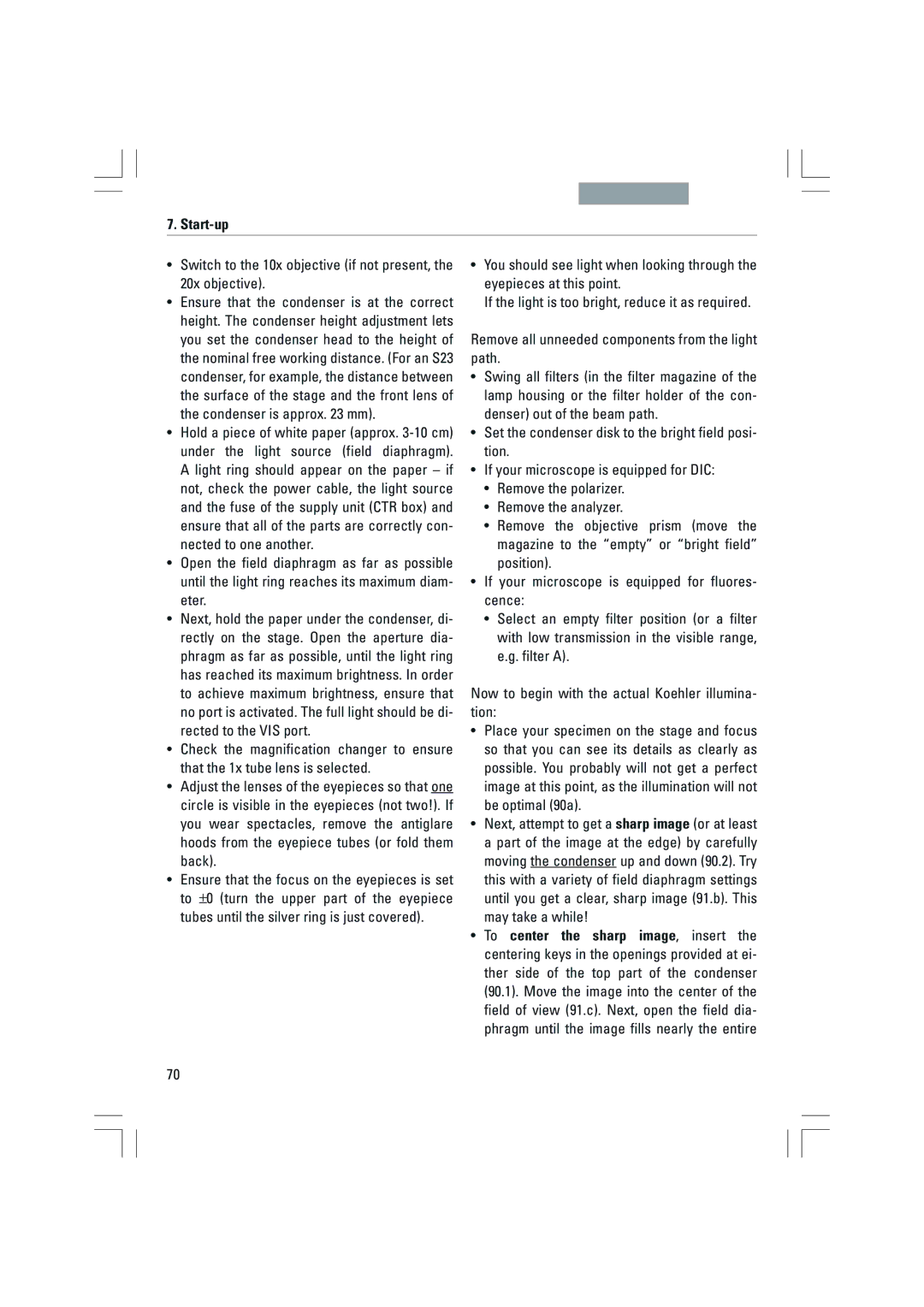Leica DMI3000B Leica DMI4000B Leica DMI6000B
MQM-Hotline@leica-microsystems.com
Leica DMI3000B Leica DMI4000B Leica DMI6000B
Copyrights
Copyrights
Contents
Differential
Important Notes about this Manual
Important Notes about this Manual
→ p
Intended Purpose of the Microscope
Intended Purpose of the Microscope
Safety Notes
Safety Notes
General Safety Notes
Microscope
Leica CTR4000, CTR6000 and CTR6500 electron- ics boxes
Ebq 100 supply unit
Ambient temperature 15Ð35C
Overview of the Instrument
Specifications Contrast Methods
Overview of the Leica DMI Series
Leica DMI Series
Tube
Incident light axis
Objective Turret
Overview of the Instrument Objective Turret
Stages
Focus
Condensers
Observation ports
Controls
Overview of the Instrument Observation ports
Electronics box
Overview of the Instrument Interfaces
Software tools
Overview of the Instrument
Field diaphragm centering fluorescence microscopes only
Overview of the Instrument
SmartMove remote control module
Overview of the Instrument
Overview of the Instrument
Overview of the Instrument
Overview of the Instrument
Unpacking the Microscope
Unpacking the Microscope
Installation location
Unpacking the Microscope Transport
Assembly Tools
Assembly
Assembling the Microscope
Assembly Installation
→ Ch .10, p
Replacing individual IC prisms
¥ Release the two socket screws and remove the prism disk
Assembly Installation of Specimen Stages
Mechanical 3-plate stage
Fixed micromanipulation stage Micromanipulation stage
Fixed stage
B, c
Able mechanical stage of the standard stage
Manual fixed micromanipulation stage
Manual fixed micromanipulation stage
Insert frames a to c differ at this
Assembly Motorized 3-plate or scanning stages
Rotating Stage and Insert Frames for Coverslips
Assembly Installation of Condensers
¥ Switch the microscope off
Phase rings
¥ Next, take the special condenser tool Fig
Installation of IC prisms
Condenser
Installation of Condensers
Assembly Condenser heads
Condenser on transmitted-light illumination arm
Installation of objectives
Assembly Installation of eyepieces
Eyepieces are inserted into the eyepiece tubes
Installing the transmitted-light lamp housing
Lamp housing cabling cable duct
Case the lamp has to be removed
Changing the 12 V 100 W halogen lamp
Right Wrong
Booster lens in stand
Lamp housing 106 z
Lamp housing 106 z L with Hg 100 W lamp
Hg 100a Xe 75b
Type
¥ Install the burner in reverse order
Assembly Make sure to follow the safety notes on
Xe 75 burner
Assembly
Assembly Equipping the Incident Light Turret Disc
Opening the fluorescence drawer 1 Analyzer slot
Load
Replacing cubes with the instrument switched on
To insert the cubes, proceed exactly as de- scribed above
Assembly Inserting the Front Module Slider
Installation of the polarizer and analyzer
Assembly Analyzer for incident light and transmitted light
Analyzer slot cap
Assembly Optional Accessories Camera
Mount
CTR 4000 electronics box
Direct interface socket optional
Assembly CTR6000 and CTR6500 electronics box
Connection to the Power Supply
Functional Principle Leica DMI4000 B and Leica DMI6000 B
Start-up
Start-up
Intelligent automation
Start-up
Function Fixed Variable
ICT
Start-up Switching on the Microscope
Start-up LeicaDisplay
Features of the individual microscope
Leica DMI 4000 B and DMI 6000 B
Start-up Function Buttons on the Stand
Fixed function buttons on the left side
ExMan
Start-up Variable function buttons on the stand
Possible functions
Fine only DMI6000B
Focus buttons DMI6000 B only
Variable function buttons on SmartMove
Preparation ¥ Configure the microscope as follows
Start-up
Start-up
Adjusting the field diaphragm
Adjusting the field diaphragm incident light-fluorescence
Start-up Checking Phase Contrast Rings
Regular phase contrast with phase objectives
Start-up
Start-up
Setting the Motorized Polarizer
Start-up Checking modulation contrast slit diaphragms
Lamp housing 107 L For 12V 100W halogen lamp
Reflector cube for lamp adjustment
Centering the Hg 100 W and Xe 75 W mercury lamps
¥ Focus the direct image with the collector
Start-up
Operation
Switching on
If a PC is connected, switch on the electronics
Operation
LeicaScreen following initialization
Operation Contrast Methods
Bright Field TL
Operation
Operation Phase Contrast TL Integrated phase contrast, see
Operation Dark Field TL
Motorized method
Operation Polarization TL
Manual method
Combined methods
DIC disk with knurled wheel for fine adjustment
Manual alternative
Operation Integrated Phase Contrast TL
Integrated Modulation Contrast TL
Options
Changing the fluorescence filter cube
Leica Application Suite LAS Software
Is facing forward
Suitable objective
Leica DMI4000 and DMI6000 B
Scope
Transmitted illumination is activated
Setting stops
Operation Focusing
Focusing the image
Leica Application Suite LAS
Operation Set the stops via
Setting the step increments
Switch between Fine and Coarse via
Going to the stops
Operation Tubes
Adjusting the viewing distance
Adjusting the viewing angle
Beam splitting in photo tubes
Operation Eyepieces
Correction for Vision Problems
Eyepieces with inlaid reticle
OIL only use optical immersion oil
Changing the operating mode
Change operating mode via
Select objectives via
White water
Color coding of objectives
Gray
Orange glycerin
Switch between Precise and Fast via
Operation Stages and Object Displacement
Object displacement using SmartMove
Storing and restoring stage positions
Magnification Changer
Operation Light sources
Fine adjustment
Adjust intensity via
¥ For TL and IL
Troubleshooting Aperture and Field Diaphragm
Adjust diaphragms via
Power supply
Troubleshooting
Problem Cause/Remedy Stand
Lamp does not illuminate immediately upon being switched on
No definite DF contrast is possible
Troubleshooting Problem Cause/Remedy Bright field
Dark Field
→ p
Polarization
Troubleshooting Problem Cause/Remedy Phase contrast
Transmitted light interference contrast
Troubleshooting Problem Cause/Remedy Fluorescence
LeicaScreen
Troubleshooting
106
Cleaning the stage
Dust Cover Cleaning
Cleaning Coated Parts
Pflege des Mikroskops
Removing Immersion Oil
Pflege des Mikroskops Cleaning Glass Surfaces
Cleaning Objectives
Handling Acids and Bases
Major Consumable and Replacement Parts
Major Consumable and Replacement Parts
109
Space requirements Height compensation plate
Dimensions
Dimensions
110
Abbreviations and Pictograms
Abbreviations and Icons
Combination method
Integrated phase contrast
Abbreviations and Icons Aperture diaphragm Bright field
Fluo cube
Index
Index
Lamp housing for incident Stand
Object displacement
Glass insert Lamp housing 107 L Objectives 17, 60 Graticule
Phase contrast
Tube 12, 16, 84 Tube setting 84 Turret disk
EU Declaration of Conformity
EU Declaration of Conformity
Leica DMI3000B Leica DMI4000B Leica DMI6000B
Copyrights
Copyrights
Inhalt
Inhalt
Wichtigste Verschlei§
Differentieller
Aperturblende und
Achtung
Wichtige Hinweise zur Anleitung
Wichtige Hinweise zur Anleitung
→ S
Zweckbestimmung des Mikroskops
Zweckbestimmung des Mikroskops
Sicherheitshinweise
Sicherheitshinweise
Allgemeine Sicherheitshinweise
Mikroskop
Elektronikbox Leica CTR4000, CTR6000 und CTR6500
VorschaltgerŠt ebq
Sicherheitshinweise Achtung
Spezifikationen Kontrastverfahren
Geräteübersicht Leica DMI-Serie
GerŠteŸbersicht
Durchlichtachse
Tubus
Auflichtachse
Objektivrevolver
GerŠteŸbersicht Objektivrevolver
Tische
Kondensoren
Fokus
Bedienelemente
Elektronikbox
GerŠteŸbersicht Schnittstellen
Software tools
GerŠteŸbersicht
Variable Funktionstasten
GerŠteŸbersicht
Abb a Frontbedienfeld
GerŠteŸbersicht
GerŠteŸbersicht
GerŠteŸbersicht
GerŠteŸbersicht
Auspacken
Auspacken
Der Stativkarton enthŠlt die folgenden Kompo- nenten
Aufstellungsort
Hinweis
Auspacken Transport
Lesen Sie dazu das Kapitel Ã6.16 Optionales ZubehšrÒ → S
Montage des Mikroskops
Montage
Montagewerkzeug
Montage des Durchlicht-BeleuchtungstrŠgers DL
Bei NachrŸstung der IC-Prismenscheibe wie folgt vorgehen
NachrŸstung einzelner IC-Prismen
Mit und ohne ObjektfŸhrer
Montage Montage der Objekttische
¥ Manueller Drehtisch
Abb Fester Mikromanipulationstisch
Fester Tisch
Des normalen Tisches
Montage Manueller fester Mikromanipulationstisch
Oder durch Lšsen der Schrauben gewechselt
Unbedingt die FederbŸgel nur seitlich andrŸk- ken
Motorische 3-Platten oder Scanningtische
Drehtisch und Einlegerahmen fŸr DeckglŠser
Montage Montage der Kondensoren
¥ Schalten Sie das Mikroskop aus
¥ Nehmen Sie nun die spezielle Kondensor- zange zu Hand Abb
Unter den FederbŸgel der Aufnahme greift Abb
Das Prisma ist so einzusetzen Kondensor
Montage IC-Kondensorprismen
Unter den FederbŸgel der Aufnahme greift Abb a
Montage Achtung
Schalten des Mikroskops mit Hilfe der
Montage Kondensorkšpfe
Einsetzen der Objektive
Montage Einsetzen der Okulare
Die Okulare werden in die Okularstutzen einge- setzt
Deshalb šfters die Frontlinse auf Sauberkeit prŸfen
Montage des Durchlicht-Lampenhauses
Elektronikbox Leica CTRxxxx an Abb Leica DMI3000 B
¥ Entfernen Sie die SchutzhŸlle der Lampe
Abb a Abb c
Richtig b falsch
Symbol sichtbar
Je nach Orientierung des Schiebers
Montage Montage und Wechsel der Auflichtlampen Achtung
Lampenhaus 106 z
Hg 100aXe 75b
Typ
Achtung Xe 75-Brenner
¥ Setzen Sie den Brenner in umgekehrter Rei- henfolge ein
SchutzhŸlle des Brenners 61.4 nach dem Einbau entfernen
Der Brenner muss nach dem ZŸnden sofort justiert werden
BestŸckung der Auflicht-Revolverscheibe
Wechseln der WŸrfel im eingeschalteten Zu- stand
Load
Einsetzen des Front-Modul Schiebers
Montage Durchlicht- und Auflichtanalysator
Montage Optionales Zubehšr Kamera
Elektronikbox CTR
HinweisHinweis
Montage Elektronikbox CTR6000 und CTR6500
Anschluss an die Stromversorgung
Funktionsprinzip Leica DMI4000 B und Leica DMI6000 B
Inbetriebnahme
Inbetriebnahme
Intelligente Automatisierung
Den kšnnen
Hinweis Reset-Funktion
Das Mikroskop kann auf die werkseitig pro
Funktion
ICT
Inbetriebnahme Einschalten
Inbetriebnahme Das LeicaDisplay
Leica DMI 4000 B und DMI 6000 B
Inbetriebnahme Die Funktionstasten am Stativ
Fest definierte Funktionstasten auf der linken Stativseite
Fine nur DMI6000B
Inbetriebnahme Variable Funktionstasten am Stativ
ExMan
Coarse nur DMI6000 B
SET + Z″
Fokus-Bedientasten Abb nur DMI6000 B
SET + Z
Das Fernsteuermodul SmartMove Drehknšpfe am SmartMove
Variable Funktionstasten am SmartMove
Kšhlersche Beleuchtung nicht fŸr S70 Kondensor
Nun beginnt die eigentliche Kšhler-Beleuch- tung
Durchmesser jedoch zu klein
Justieren der Leuchtfeldblende
Inbetriebnahme Phasenkontrastringe ŸberprŸfen
¥ Fokussieren Sie das PrŠparat
Inbetriebnahme
Inbetriebnahme Modulationskontrast Schlitzblenden ŸberprŸfen
Einstellung des motorischen Polarisators
Lampenhaus 107 L FŸr HalogenglŸhlampe 12 V 100 W
Zentrieren der Quecksilberlampen Hg 100 W und Xe 75 W
Inbetriebnahme Achtung
¥ Stellen Sie das direkte Bild mit dem Kollektor scharf
Inbetriebnahme
Computer ein
Bedienung
Bedienung
Verfahren weiter
Bedienung
Bedienung Kontrastverfahren
Hellfeld TL
Bedienung
Bedienung Phasenkontrast TL
Hinweise
Bedienung Dunkelfeld TL Hinweise
Manuelles Verfahren
Bedienung Polarisation TL
¥ WŠhlen Sie das Kontrastverfahren POL Pola- risation
Motorisches Verfahren
Leica DMI3000 B ¥ WŠhlen Sie ein Objektiv
Manuelle Alternative
Bedienung Integrierter Phasenkontrast TL
Alternativ DrŸcken Sie die variable Taste
Wechsel des Fluoreszenz-FilterwŸrfels
Optionen
Nach vorne zeigt
Feste Funktionstasten am Frontbedien
Die Durchlichtbeleuchtung ist aktiviert
Bedienung Kombi-Verfahren Leica DMI4000 und DMI6000 B
Die Fluoreszenzbeleuchtung ist aktiviert
Den
Bedienung Fokussierung
Bild fokussieren
Schwellen setzen
Anfahren der Schwellen Ÿber
Bedienung Setzen der Schwellen Ÿber
Anfahren der Schwellen
Einstellen der Schrittweiten
Einblickwinkel einstellen
Bedienung Tuben Hinweis
Augenabstand einstellen
Strahlenteilung bei Fototuben
Okulare mit eingelegter Strichplatte
Bedienung Okulare Hinweis
Korrektur bei Fehlsichtigkeit
Wechsel des Betriebsmodus
Sicherheitsdatenblatt zum Immersionsšl be- achten
Anfahren der Objektive Ÿber
Betriebsmodus wechseln Ÿber
150x 160x Wei§
Bedienung HinweisHinweis
Farbkennung der Objektive
Rot
Umschalten zwischen Precise und Fast Ÿber
Bedienung Tische und Objektverschiebung
Objektverschiebung Ÿber SmartMove
Tischpositionen speichern und anfahren
Bedienung Vergrš§erungswechsler
Vergrš§erung wechseln Ÿber
Licht einstellen Ÿber
Bedienung Lichtquellen
¥ Bei TL und IL
100
Trouble Shooting Aperturblende und Leuchtfeldblende
Blenden einstellen Ÿber
Problem Ursache/Abhilfe Stativ
Trouble Shooting
Beleuchtung
Problem Ursache/Abhilfe Hellfeld
Trouble Shooting
Dunkelfeld
Polarisation
Trouble Shooting Problem Ursache/Abhilfe Phasenkontrast
Durchlicht-Interferenzkontrast
Problem Ursache/Abhilfe Fluoreszenz
LeicaDisplay
106
Pflege des Mikroskops
Entfernen von Immersionsšl Achtung
Pflege des Mikroskops Reinigen von GlasflŠchen
Reinigen von Objektiven Achtung
Umgang mit SŠuren und Basen
Wichtigste Verschlei§- und Ersatzteile
Wichtigste Verschleiß- und Ersatzteile
109
Platzbedarf Hšhenausgleichsplatte
Abmessungen
Abmessungen
110
Abkürzungen und Piktogramme
AbkŸrzungen und Piktogramme
Hellfeld
Integrierter Phasenkontrast
Phasenkontrast
Kombinationsverfahren
Index
Index
Leica-Zugriff Fokus
Lampenversorgungskabel
Initialisierung Des Stativs
Kamera Leuchtfeldblenden
10, 46, 47, 54
EU-Konformitätserklärung
EU-KonformitŠtserklŠrung
Page
Ordernos.oftheeditionsinEnglish/German/French933000

